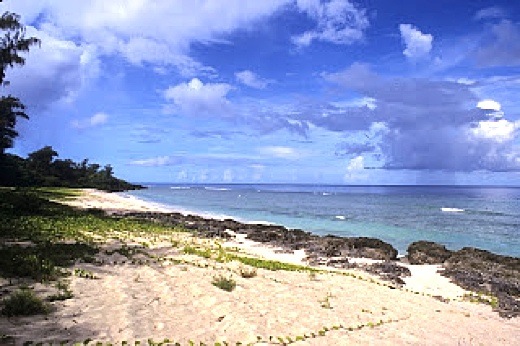SOURCE: Koohan Paik (koohanpaik@gmail.com)
SUBHEAD: Among the impacts - ocean mammals will isustain hearing loss, lung damage, and death.
By Haidee V. Eugenio on 17 December 2013 for the Saipan Tribune -
(http://www.saipantribune.com/newsstory.aspx?cat=1&newsID=152351)

Image above: On this beach on Tinian island the U.S. Marines came ashore to capture this island from the Japanese. Later this island became had the busiest airbase in the world in the firebombing of Japan. A holocaust that likely killed over a million people. From (http://avcblogs.blogspot.com/2011/04/in-praise-of-veterans.html).
[Note from Source: This article, published by the Saipan Tribune, is an interesting account of how the governor of the Commonwealth of the Northern Mariana Islands (CNMI) is responding to the Mariana Islands Testing and Training (MITT), which is the U.S. military's proposal to bomb the Mariana Islands and surrounding million-square-miles of open seas to smithereens.
This article reveals, among other facts, how hull-mounted mid-frequency sonar attempts would translate to at least 104 days per a 365 day year based on a 2,500 hour usage rate. Add on an additional 1,000 hours then you get 145 days out of a 365 day year.
Also, 984 explosions of underwater explosives is close to 3 explosions per day based on a 365 day year. Temporary hearing loss to marine mammals based on 133,510 instances based on a 365 day year is close to 366 instances of temporary hearing loss to marine mammals each day and close to 1 instance of permanent hearing loss per day.]
Gov. Eloy S. Inos said the U.S. Department of Defense’s efforts to increase control over property belonging to the CNMI is “in conflict and contrary to Section 802 of the Covenant” that established the Northern Marianas’ political relationship with the United States. His administration is also “deeply concerned” about the proposed military activities’ impact on CNMI marine wildlife, particularly marine mammals “which remain grossly understudied in the region.”
Inos submitted comments to the U.S. Navy’s draft environmental impact statement for the Mariana Islands Training and Testing, or MITT, area.
His 11-page letter was dated Dec. 11, a day before the deadline for comments submission.
The governor said he and many of the CNMI’s political leaders are “profoundly troubled by the expansive efforts of the Department of Defense to acquire additional property and control over our islands and the waters adjacent thereto for military [or defense] purposes.”
He said these increased DoD efforts to control CNMI property is in conflict and contrary to the Covenant.
“The MITT final environmental impact statement evaluating training and testing within the Mariana Islands Range Complex must consider the military’s proposal to control more CNMI property in relation to the provisions in Section 802 of the CNMI Covenant,” the governor said.
Under Section 802, the U.S. affirmed that it has no need for or intention to acquire any greater interest in property belonging to the CNMI.
The draft EIS indicates the Navy intends to further intensify its activities around the islands, as part of an increased deployment into the Western Pacific that began in the last decade.
Under its preferred alternative, the Navy would annually run approximately 2,500 hours of hull-mounted, mid-frequency sonar and many more thousands of hours of active acoustics.
Each year, it would detonate about 984 in-water explosives with a net explosive charge of 5 lbs or greater.
This is in addition to thousands of smaller explosives and other types of ordnance.
“Collectively, these activities are associated with a variety of environmental impacts on marine mammals and other marine biota, including disruptions in foraging and other vital behaviors, hearing loss, physical injury such as lung damage, and mortality,” the governor said in his letter addressed to Naval Facilities Engineering Command, Pacific.
He said the draft EIS itself estimates that Navy activities would subject marine mammals to some 133,510 instances of temporary hearing loss and 285 cases of permanent hearing loss or injury.
The governor recommends the establishment of marine mammal mitigation areas within the CNMI, and additional effort at baseline data acquisition.

Image above: Photo of the US Airforce Enola Gay bomber in 1945 on Tinian island before it was loaded with the atomic bomb that was dropped on Hiroshima. Bomb dropped on Nagasaki also came from Tinian island. From (http://avcblogs.blogspot.com/2011/04/in-praise-of-veterans.html).
Among his specific recommendations is the exclusion of sonar and explosives training and testing from the vicinity of the islands of the CNMI.
The governor also recommends further study, such as the conduct of small-vessel surveys on the islands north of Tinian, and a towed passive acoustic survey.
“The CNMI looks forward to working with the Navy on implementing these provisions and furthering our mutual interests in the protection of marine species,” Inos added.
Prior to submitting his comments, the governor and Lt. Gov. Jude U. Hofschneider urged agencies to submit their individual comments on the draft EIS.
One of the responding local agencies was the Department of Lands and Natural Resources, which said that a proposed increase in the level of U.S. military bombings on Farallon de Medinilla and amphibious vehicle landing exercises on Tinian beaches, among other things, pose “significant impacts” on local resources but many of these effects were absent in the draft EIS.
For example, bombs up to 200 lbs are and will be allowed to be dropped on Farallon de Medinilla island (FDM) and such explosives would significantly disrupt soil and reefs.
But the draft EIS “failed to provide this as a potential impact of increased bombing of FDM,” DLNR officials and biologists said.
FDM is the only area in the CNMI that the U.S. military uses for live fire training since 1976.
An entirely separate proposal seeks to use Tinian and Pagan, also for live-fire training.
.
SUBHEAD: Among the impacts - ocean mammals will isustain hearing loss, lung damage, and death.
By Haidee V. Eugenio on 17 December 2013 for the Saipan Tribune -
(http://www.saipantribune.com/newsstory.aspx?cat=1&newsID=152351)

Image above: On this beach on Tinian island the U.S. Marines came ashore to capture this island from the Japanese. Later this island became had the busiest airbase in the world in the firebombing of Japan. A holocaust that likely killed over a million people. From (http://avcblogs.blogspot.com/2011/04/in-praise-of-veterans.html).
[Note from Source: This article, published by the Saipan Tribune, is an interesting account of how the governor of the Commonwealth of the Northern Mariana Islands (CNMI) is responding to the Mariana Islands Testing and Training (MITT), which is the U.S. military's proposal to bomb the Mariana Islands and surrounding million-square-miles of open seas to smithereens.
This article reveals, among other facts, how hull-mounted mid-frequency sonar attempts would translate to at least 104 days per a 365 day year based on a 2,500 hour usage rate. Add on an additional 1,000 hours then you get 145 days out of a 365 day year.
Also, 984 explosions of underwater explosives is close to 3 explosions per day based on a 365 day year. Temporary hearing loss to marine mammals based on 133,510 instances based on a 365 day year is close to 366 instances of temporary hearing loss to marine mammals each day and close to 1 instance of permanent hearing loss per day.]
Gov. Eloy S. Inos said the U.S. Department of Defense’s efforts to increase control over property belonging to the CNMI is “in conflict and contrary to Section 802 of the Covenant” that established the Northern Marianas’ political relationship with the United States. His administration is also “deeply concerned” about the proposed military activities’ impact on CNMI marine wildlife, particularly marine mammals “which remain grossly understudied in the region.”
Inos submitted comments to the U.S. Navy’s draft environmental impact statement for the Mariana Islands Training and Testing, or MITT, area.
His 11-page letter was dated Dec. 11, a day before the deadline for comments submission.
The governor said he and many of the CNMI’s political leaders are “profoundly troubled by the expansive efforts of the Department of Defense to acquire additional property and control over our islands and the waters adjacent thereto for military [or defense] purposes.”
He said these increased DoD efforts to control CNMI property is in conflict and contrary to the Covenant.
“The MITT final environmental impact statement evaluating training and testing within the Mariana Islands Range Complex must consider the military’s proposal to control more CNMI property in relation to the provisions in Section 802 of the CNMI Covenant,” the governor said.
Under Section 802, the U.S. affirmed that it has no need for or intention to acquire any greater interest in property belonging to the CNMI.
The draft EIS indicates the Navy intends to further intensify its activities around the islands, as part of an increased deployment into the Western Pacific that began in the last decade.
Under its preferred alternative, the Navy would annually run approximately 2,500 hours of hull-mounted, mid-frequency sonar and many more thousands of hours of active acoustics.
Each year, it would detonate about 984 in-water explosives with a net explosive charge of 5 lbs or greater.
This is in addition to thousands of smaller explosives and other types of ordnance.
“Collectively, these activities are associated with a variety of environmental impacts on marine mammals and other marine biota, including disruptions in foraging and other vital behaviors, hearing loss, physical injury such as lung damage, and mortality,” the governor said in his letter addressed to Naval Facilities Engineering Command, Pacific.
He said the draft EIS itself estimates that Navy activities would subject marine mammals to some 133,510 instances of temporary hearing loss and 285 cases of permanent hearing loss or injury.
The governor recommends the establishment of marine mammal mitigation areas within the CNMI, and additional effort at baseline data acquisition.

Image above: Photo of the US Airforce Enola Gay bomber in 1945 on Tinian island before it was loaded with the atomic bomb that was dropped on Hiroshima. Bomb dropped on Nagasaki also came from Tinian island. From (http://avcblogs.blogspot.com/2011/04/in-praise-of-veterans.html).
Among his specific recommendations is the exclusion of sonar and explosives training and testing from the vicinity of the islands of the CNMI.
The governor also recommends further study, such as the conduct of small-vessel surveys on the islands north of Tinian, and a towed passive acoustic survey.
“The CNMI looks forward to working with the Navy on implementing these provisions and furthering our mutual interests in the protection of marine species,” Inos added.
Prior to submitting his comments, the governor and Lt. Gov. Jude U. Hofschneider urged agencies to submit their individual comments on the draft EIS.
One of the responding local agencies was the Department of Lands and Natural Resources, which said that a proposed increase in the level of U.S. military bombings on Farallon de Medinilla and amphibious vehicle landing exercises on Tinian beaches, among other things, pose “significant impacts” on local resources but many of these effects were absent in the draft EIS.
For example, bombs up to 200 lbs are and will be allowed to be dropped on Farallon de Medinilla island (FDM) and such explosives would significantly disrupt soil and reefs.
But the draft EIS “failed to provide this as a potential impact of increased bombing of FDM,” DLNR officials and biologists said.
FDM is the only area in the CNMI that the U.S. military uses for live fire training since 1976.
An entirely separate proposal seeks to use Tinian and Pagan, also for live-fire training.
.
No comments :
Post a Comment